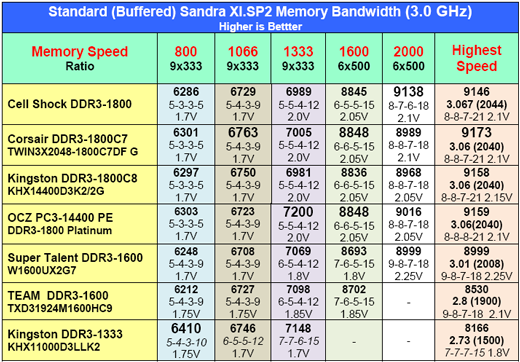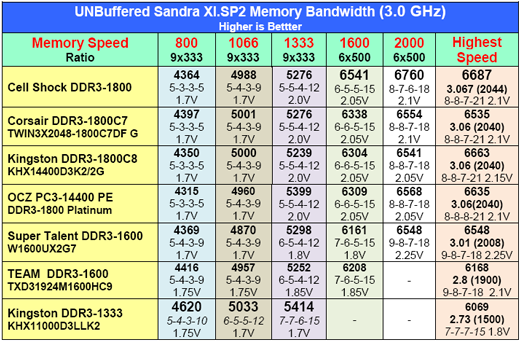Cell Shock, Corsair, and Kingston Introduce Ultra Speed DDR3
by Wesley Fink on October 11, 2007 10:00 PM EST- Posted in
- Memory
Bandwidth and Memory Scaling
As you saw in the overclocking graph on the previous page, all five of the memories based on Micron Z9 memory chips reached a stable overclock of more than 2000MHz. This remarkable overclock should translate into higher bandwidth with DDR3 at higher speeds.
To better understand memory performance at speeds from DDR3-800 to DDR3-2000+ we compared Standard or Buffered bandwidth of the Cell Shock DDR3-1800, Corsair DDR3-2800C7, and Kingston DDR3-1800C7 at all tested speeds. The processor in each case is running 3.0 GHz as detailed in the Memory Test Configuration on page three. The bandwidths of the three new memories tested in this review were then compared to all DDR3 memory we have tested to date.
At DDR3-800 the Elpida LL based Kingston is the best performer in the standard Sandra bandwidth test. However, at 1066 the lead now shifts to the Corsair 1800, OCZ DDR3-1800 at 1300, Corsair at 1600, Cell Shock at 2000, and the Corsair again at the highest speed. The Micron Z9-based memories now own the bandwidth records at 1066 to the highest speed that can be reached, which is 2044MHz. There is no clear winner among the five Micron memories, with a very tight clustering of results across the test results.
We also test memory with buffering schemes like MMX, SSE, SSE2, SSE3, etc, turned off. While these features do provide apparent improved bandwidth, the Unbuffered bandwidth tends to correlate better with real-world application performance. Unbuffered performance does not always follow the same pattern of buffered memory performance.
The unbuffered results are very interesting, and the memory bandwidth does not really behave the same as the standard buffered test results. There are really two standout memories in this test. The low-latency Elpida-based Kingston DDR3-1333 is top performer at 800, 1066, and 1333. When speed is cranked up to the upper DDR3 speeds, however, the winner is Cell Shock - which tops Unbuffered test results at 1600, 2000, and the highest speed of 2044. Cell Shock appears to have paid careful attention to the types of memory performance that matter most to enthusiasts, which is likely why the new brand has been so well received at enthusiast sites.
This should not be misconstrued, however. Once again the test results from all five Micron based memory kits are very close, and nothing really stood out among this group. The Super Talent was the first Micron Z9 out of the gate, and as such it did not have the benefit of other manufacturers' experiences to help in final binning and programming the SPD. A retest of a more recent Super Talent memory kit will likely show Super Talent has undergone some tweaks with the performance now neck and neck with the other recent Micron entries.
As you saw in the overclocking graph on the previous page, all five of the memories based on Micron Z9 memory chips reached a stable overclock of more than 2000MHz. This remarkable overclock should translate into higher bandwidth with DDR3 at higher speeds.
To better understand memory performance at speeds from DDR3-800 to DDR3-2000+ we compared Standard or Buffered bandwidth of the Cell Shock DDR3-1800, Corsair DDR3-2800C7, and Kingston DDR3-1800C7 at all tested speeds. The processor in each case is running 3.0 GHz as detailed in the Memory Test Configuration on page three. The bandwidths of the three new memories tested in this review were then compared to all DDR3 memory we have tested to date.
 |
| Click chart to enlarge |
At DDR3-800 the Elpida LL based Kingston is the best performer in the standard Sandra bandwidth test. However, at 1066 the lead now shifts to the Corsair 1800, OCZ DDR3-1800 at 1300, Corsair at 1600, Cell Shock at 2000, and the Corsair again at the highest speed. The Micron Z9-based memories now own the bandwidth records at 1066 to the highest speed that can be reached, which is 2044MHz. There is no clear winner among the five Micron memories, with a very tight clustering of results across the test results.
We also test memory with buffering schemes like MMX, SSE, SSE2, SSE3, etc, turned off. While these features do provide apparent improved bandwidth, the Unbuffered bandwidth tends to correlate better with real-world application performance. Unbuffered performance does not always follow the same pattern of buffered memory performance.
 |
| Click chart to enlarge |
The unbuffered results are very interesting, and the memory bandwidth does not really behave the same as the standard buffered test results. There are really two standout memories in this test. The low-latency Elpida-based Kingston DDR3-1333 is top performer at 800, 1066, and 1333. When speed is cranked up to the upper DDR3 speeds, however, the winner is Cell Shock - which tops Unbuffered test results at 1600, 2000, and the highest speed of 2044. Cell Shock appears to have paid careful attention to the types of memory performance that matter most to enthusiasts, which is likely why the new brand has been so well received at enthusiast sites.
This should not be misconstrued, however. Once again the test results from all five Micron based memory kits are very close, and nothing really stood out among this group. The Super Talent was the first Micron Z9 out of the gate, and as such it did not have the benefit of other manufacturers' experiences to help in final binning and programming the SPD. A retest of a more recent Super Talent memory kit will likely show Super Talent has undergone some tweaks with the performance now neck and neck with the other recent Micron entries.










12 Comments
View All Comments
geok1ng - Thursday, August 28, 2008 - link
looking at http://www.anandtech.com/mb/showdoc.aspx?i=3208&am...">http://www.anandtech.com/mb/showdoc.aspx?i=3208&am... one may wish that an E8600 can reach 10x400Mhz using 2:1 divider + tRD 5 + DDR3 1600 for top notch performance. I look forward for FSB 400/DDR3 1600 CAS 6 examples of memory performance.mandos9 - Tuesday, November 6, 2007 - link
"The recent performance improvements in DDR3 memory have far exceeded anything the end user or industry expected to see in such a short period of time. "The performance improvement is,in comparison to ddr2,5-7fps.That's almost nothing,especially when the games you test already run at 100+ fps(why don't you test it on the crysis demo or games that have come out more recently?).
I don't see why i should spend 600(or 300 for that matter) euro to upgrade my pc, when i can buy a second 8800GT for 250 euro and get 30 or more fps.
Nobody would buy ddr3 for performance. I can only see me buying it if i want a new mobo which i will not have to replace in a year or two.
nrb - Monday, October 15, 2007 - link
Oh joy, yet another anandtech article where I can't see any of the graphs. How many more years are you guys going to allow this to go on?(sigh)
Wesley Fink - Monday, October 15, 2007 - link
The charts are all there. We can read them fine in IE and Firefox. I just double-chescked to make sure there are no broken links. Can you please let us know what you are using as a browser?DrMrLordX - Saturday, October 13, 2007 - link
Why have you not included latency numbers as measured in cycles and/or nanoseconds?goinginstyle - Friday, October 12, 2007 - link
Do you think we could see a DDR2 memory review? Only about 90% of the desktop systems released in the last couple of years use it and considering the unbelievably low prices now it would be nice to see a review of memory that people actually use. It is getting boring to see $650~$900 memory reviewed when most of us cannot even begin to think about buying it or even can afford it if we wanted to change. Show us some results on memory that most people use now.Wesley Fink - Monday, October 15, 2007 - link
The Kingston DDR3, which performed at the top of our test results, has a MSRP of $450 for the 2GB kit - NOT 650-900. It is still much higher than DDR2 but prices are starting to come down.We do have a DDR2 roundup coming in the near future. However, if you look back at the DDR2 review you will find many of the currently available DDR2 memory has been reviewed at AT before the introduction of DDR3.
retrospooty - Friday, October 12, 2007 - link
at DDR 2000 at 6X500 CPU the best sisoft standard memory score for DDR3 is 9138 at DDR3 2000 8-7-6-18 ... I get 8871 with my DDR2 1000mhz at 4-4-4-10 with a similar setup on a DFI P35 mobo.Thats a lot of cash for an extra 267 mb per second bandwidth. Granted my memory setting are highly tuned, but the speed difference is even smaller than I had imagined. I would say the "dramatic" speed increases are totally crippled by the "dramatic" latency penalties. Hopefully in a year or 2 we will see some lower latencies.
Wesley Fink - Monday, October 15, 2007 - link
Congratulations on your great Buffered bandwidth scores with DDR2. We use a standardized setup and do not really tweak timings as you have. Any of our test results can ge tweaked to produce much higher test results, so it is best to compare apples to apples.At 1066 our DDR3 at 5-4-3-9 timings is an Sandra bandwidth of 6763, while you get 8871, a difference of 2100+. We are confident we could tweak the 1066 timings to pick up the 2100 points since the latest DDR-3 based on Z9 chips is testing equal or faster than the fastest DDR2 at the same speed at 1066 or above. That means DDR3-2000 could be 2300+ higher when tweaked for top bandwidth. In addition the fastest possible BIOS timings at 1066 with DDR3 are 5-3-3-5, and we are not far from that.
If you check some enthusiast postings where they tweak the DDR3 for bandwidth you will find bandwidths exceeding 11000 on Sandra with Z9 based dimms. I suspect you already know this.
Anonymous Freak - Thursday, October 11, 2007 - link
At the top of each page of the article is the list of places to buy:That's all well and good. But the last four are the same company. (Ritz Camera owns Wolf, Camera World, and PhotoAlley.)